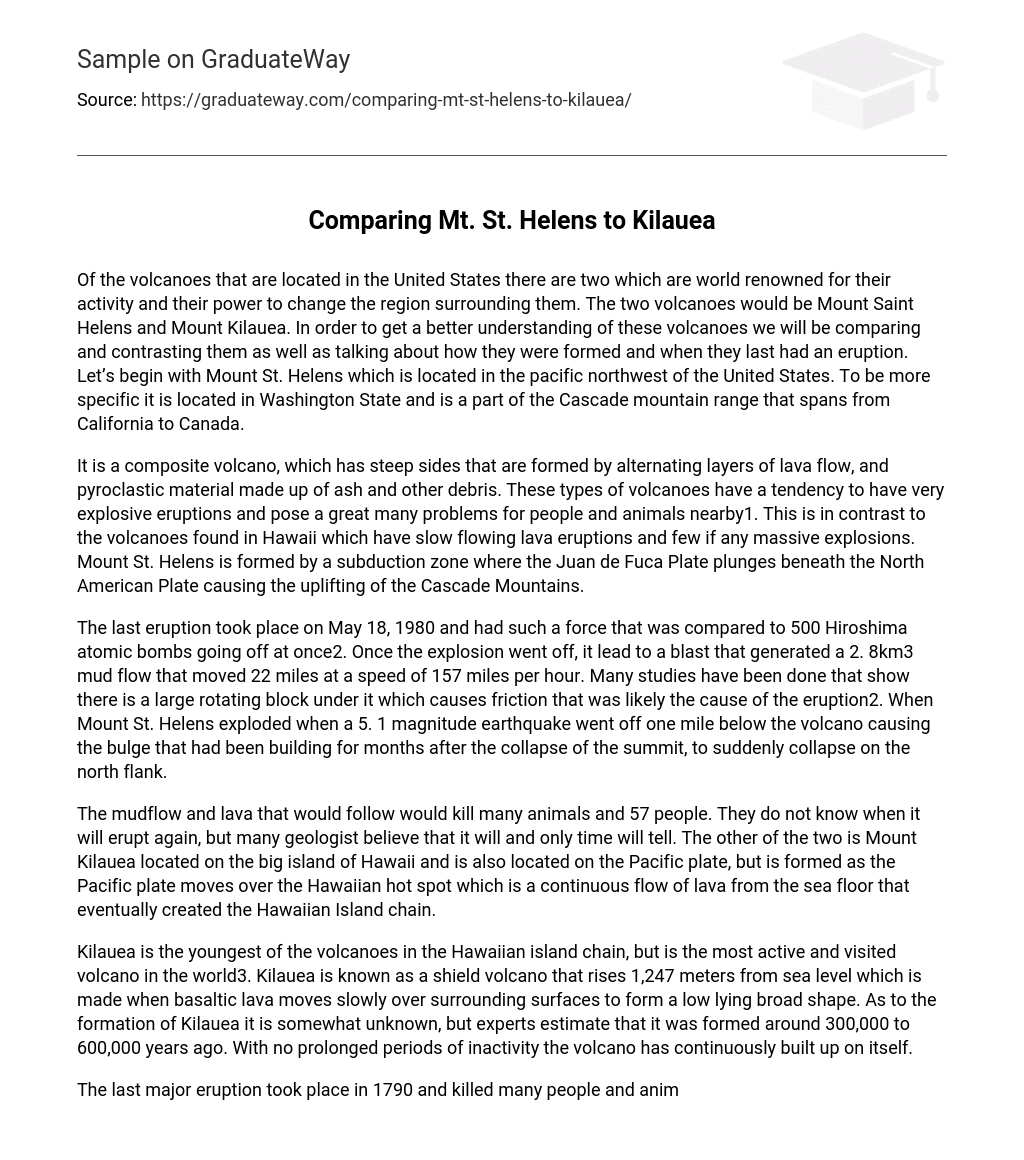Of the volcanoes that are located in the United States there are two which are world renowned for their activity and their power to change the region surrounding them. The two volcanoes would be Mount Saint Helens and Mount Kilauea. In order to get a better understanding of these volcanoes we will be comparing and contrasting them as well as talking about how they were formed and when they last had an eruption. Let’s begin with Mount St. Helens which is located in the pacific northwest of the United States. To be more specific it is located in Washington State and is a part of the Cascade mountain range that spans from California to Canada.
It is a composite volcano, which has steep sides that are formed by alternating layers of lava flow, and pyroclastic material made up of ash and other debris. These types of volcanoes have a tendency to have very explosive eruptions and pose a great many problems for people and animals nearby1. This is in contrast to the volcanoes found in Hawaii which have slow flowing lava eruptions and few if any massive explosions. Mount St. Helens is formed by a subduction zone where the Juan de Fuca Plate plunges beneath the North American Plate causing the uplifting of the Cascade Mountains.
The last eruption took place on May 18, 1980 and had such a force that was compared to 500 Hiroshima atomic bombs going off at once2. Once the explosion went off, it lead to a blast that generated a 2. 8km3 mud flow that moved 22 miles at a speed of 157 miles per hour. Many studies have been done that show there is a large rotating block under it which causes friction that was likely the cause of the eruption2. When Mount St. Helens exploded when a 5. 1 magnitude earthquake went off one mile below the volcano causing the bulge that had been building for months after the collapse of the summit, to suddenly collapse on the north flank.
The mudflow and lava that would follow would kill many animals and 57 people. They do not know when it will erupt again, but many geologist believe that it will and only time will tell. The other of the two is Mount Kilauea located on the big island of Hawaii and is also located on the Pacific plate, but is formed as the Pacific plate moves over the Hawaiian hot spot which is a continuous flow of lava from the sea floor that eventually created the Hawaiian Island chain.
Kilauea is the youngest of the volcanoes in the Hawaiian island chain, but is the most active and visited volcano in the world3. Kilauea is known as a shield volcano that rises 1,247 meters from sea level which is made when basaltic lava moves slowly over surrounding surfaces to form a low lying broad shape. As to the formation of Kilauea it is somewhat unknown, but experts estimate that it was formed around 300,000 to 600,000 years ago. With no prolonged periods of inactivity the volcano has continuously built up on itself.
The last major eruption took place in 1790 and killed many people and animals, but numbers are unknown4. Starting in 1983 there was a chain of several eruptions that started and have yet to stop pushing lava through a lava tube till it reaches the Pacific Ocean. Over a span of twenty year the flow has changed course and add new land to the island. There are several things that they have in common as they also have many differences. They both have something to do with the Pacific Plate and they both have had explosions.
They are much more different though than they are alike. For starters Mt. St. Helen is located in the “ring of fire” whereas Kilauea is on a hot spot in the Pacific Ocean. Mt. St. Helens is more explosive when it goes off after years of building pressure, where Kilauea has few explosions, but a continuous flow of lava. They both attract tourism, but Kilauea draws much more people who want to see lava flows and Mt. St. Helens draws people that want to recreational and hike camp and fish in the area around the mountain.
In closing they both have the power to kill and change their environment some are just more extreme and devastating when they go off.
Bibliography:
1. http://mountsthelens. com/
2. http://0-go. galegroup. com. catalog. poudrelibraries. org/ps/retrieve. do inPS=true&prodId=GVRL&userGroupName=fcollinspl&docId=GALE%7CCX1918700958&contentSegment=&searchId=R1&tabID=T003&resultListType=RESULT_LIST¤tPosition=1
3. http://www. buzzle. com/articles/mount-kilauea-volcano-hawaii-volcano. html 4. http://www. georesources. co. uk/kilauea. htm





